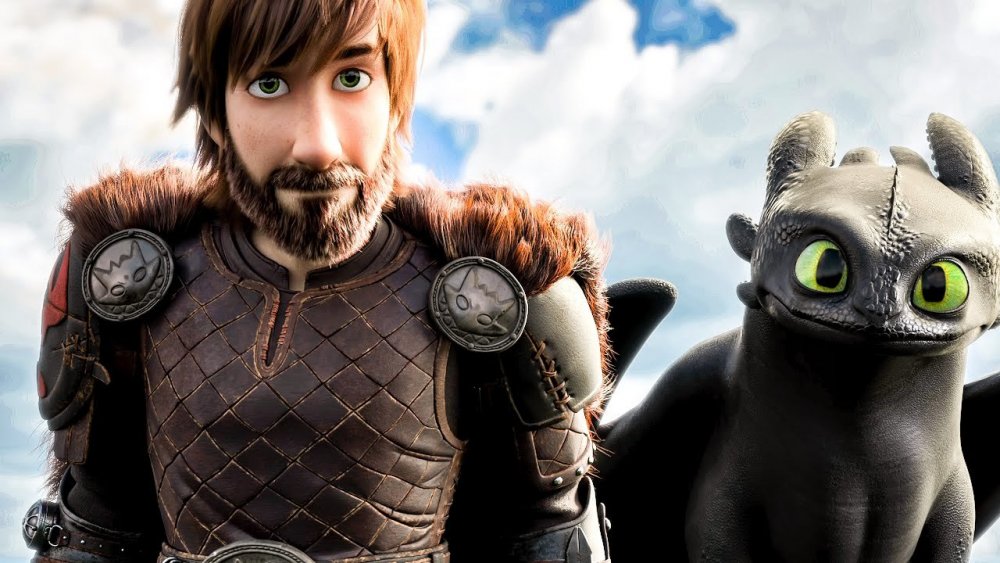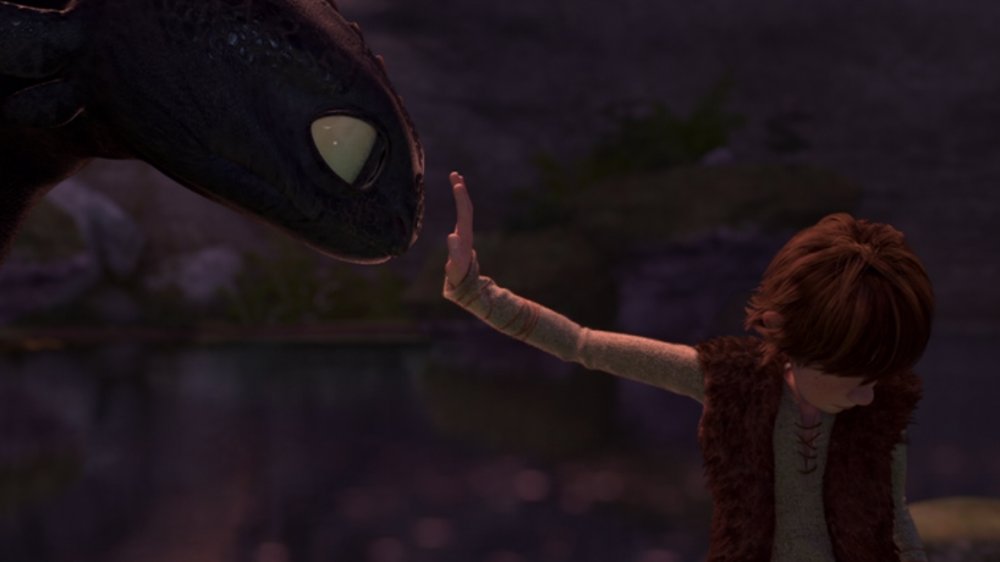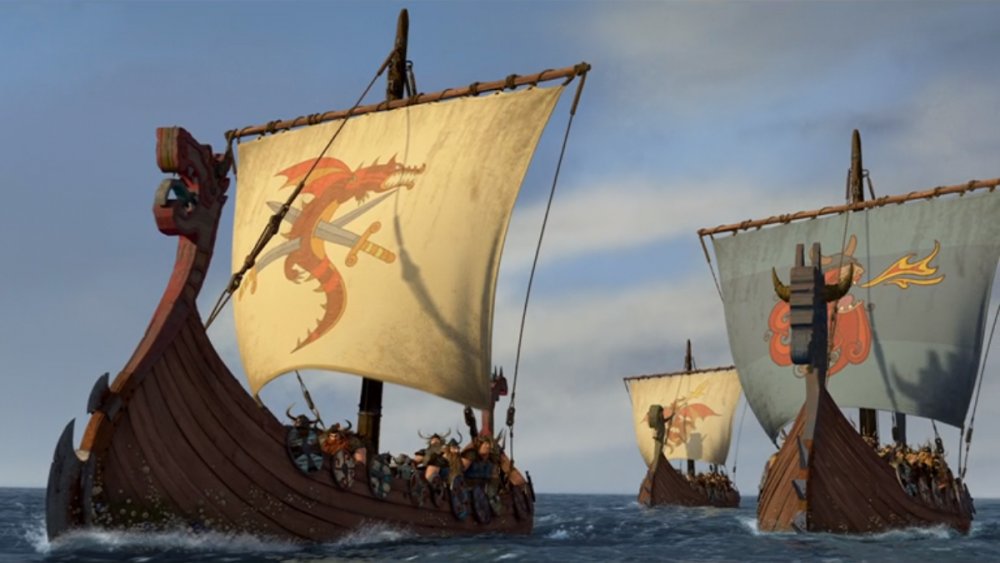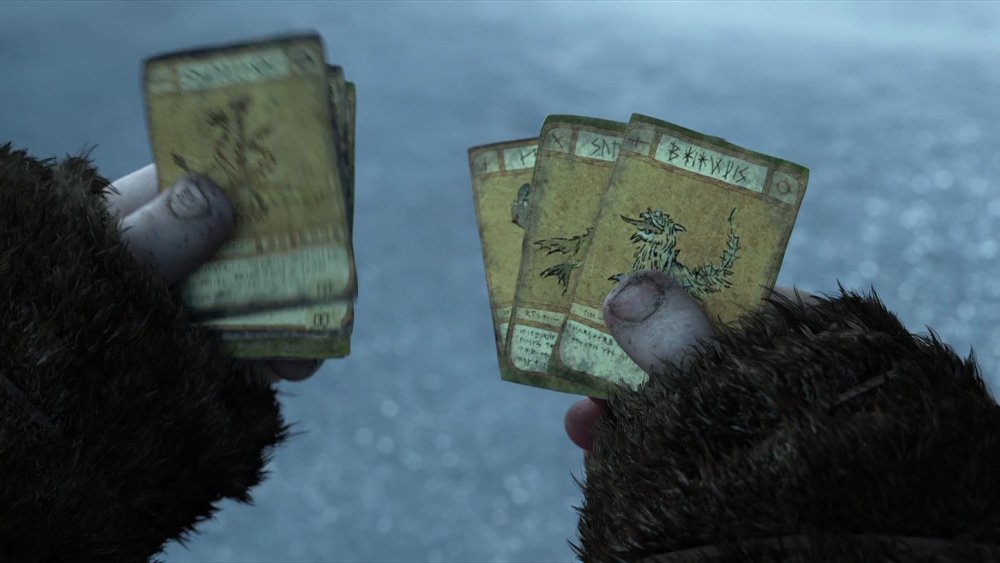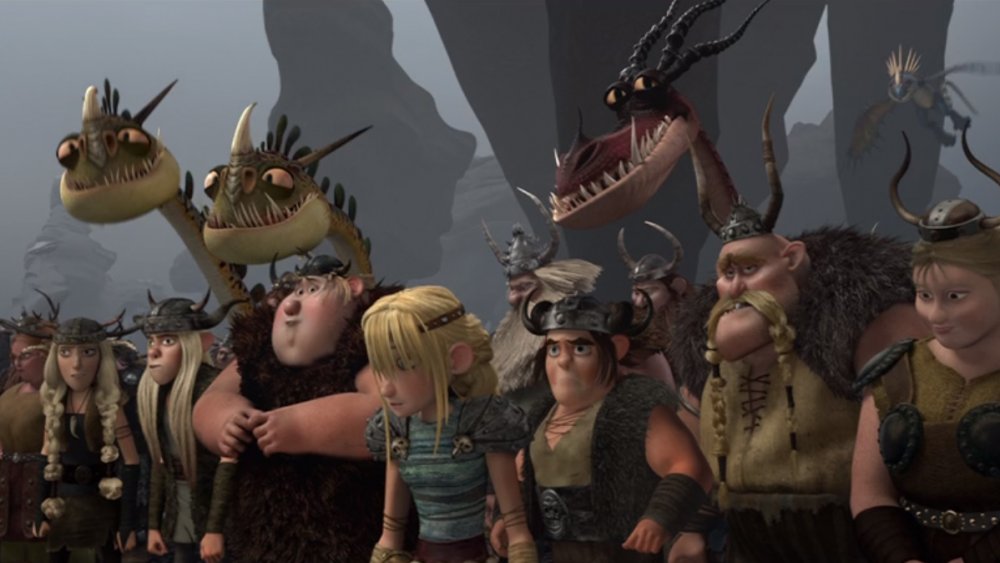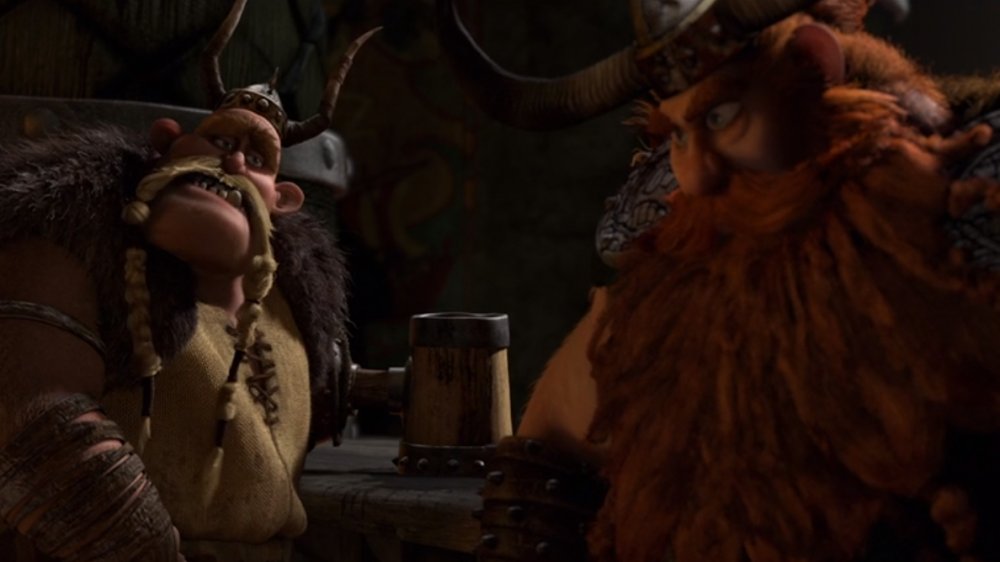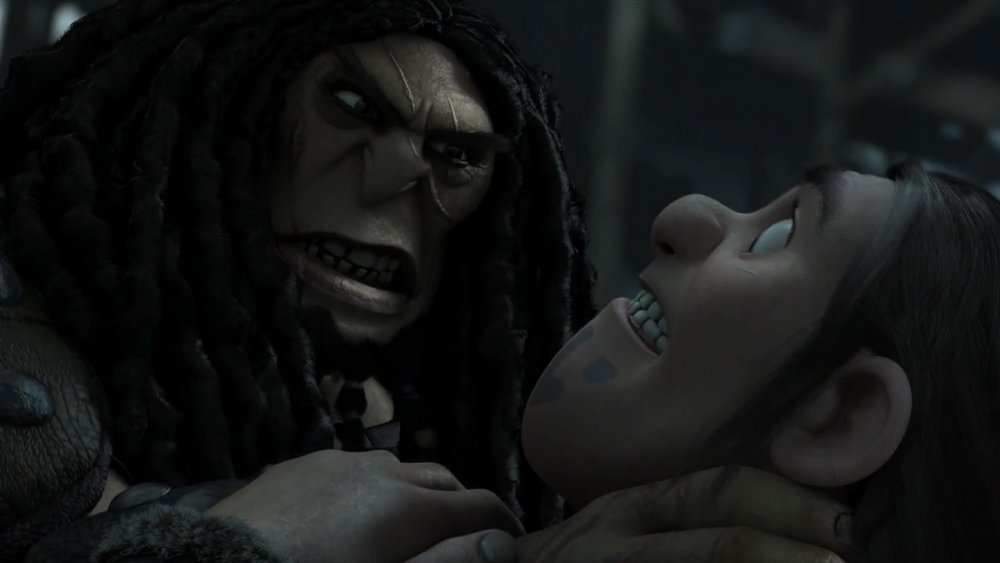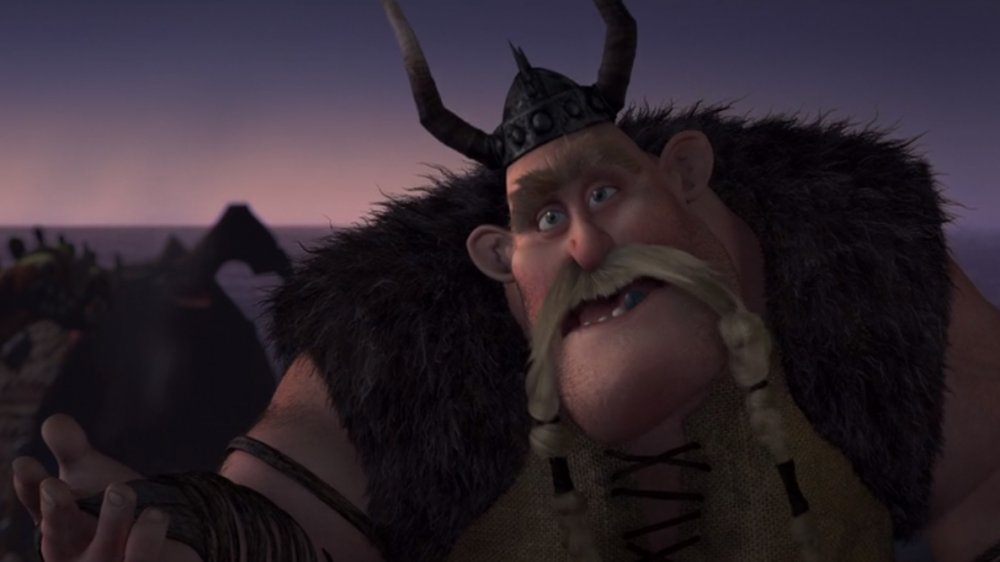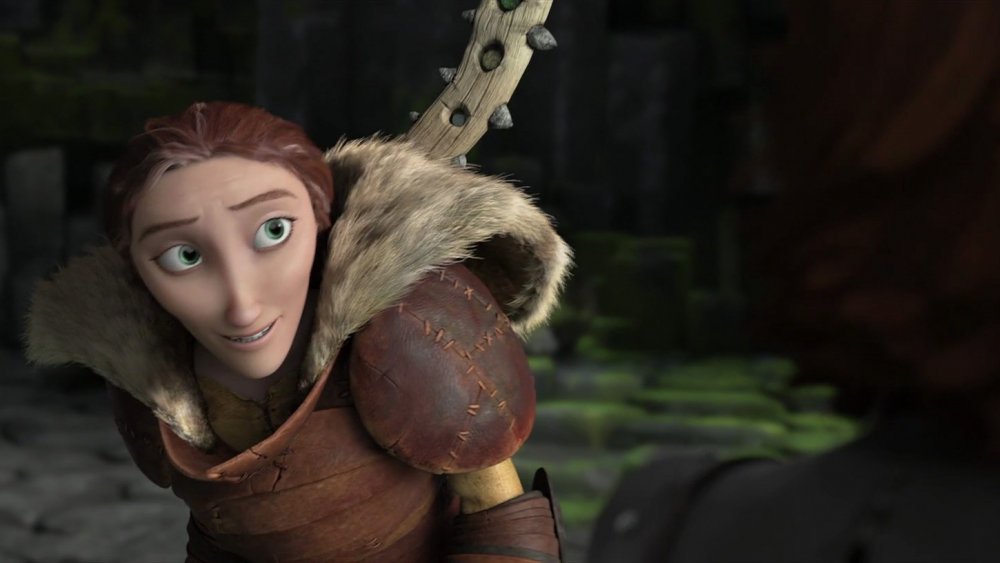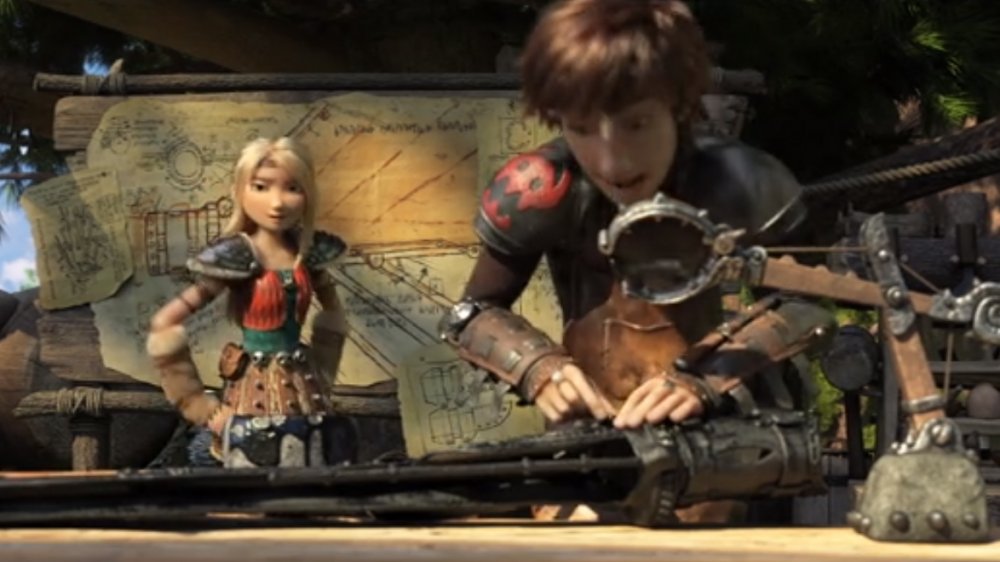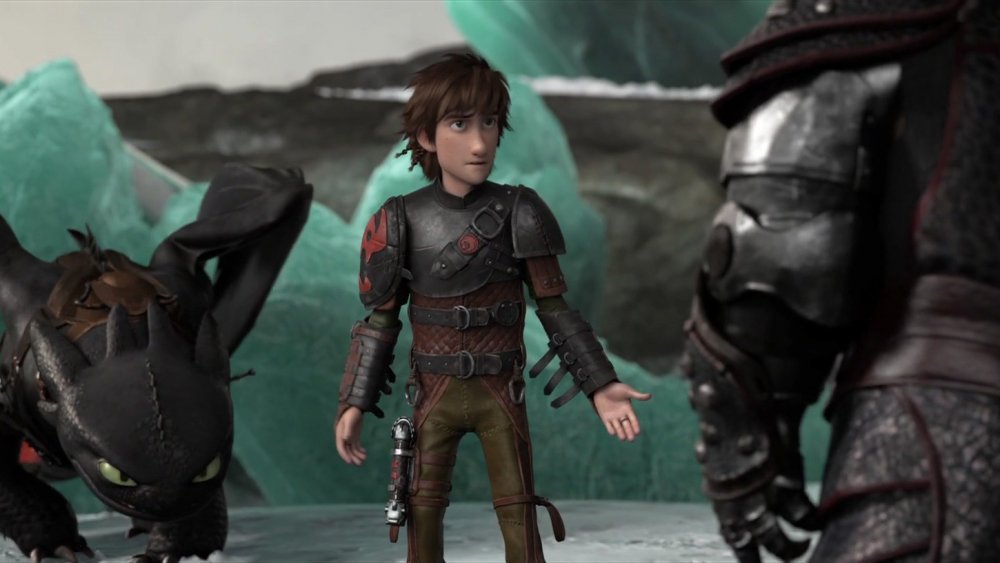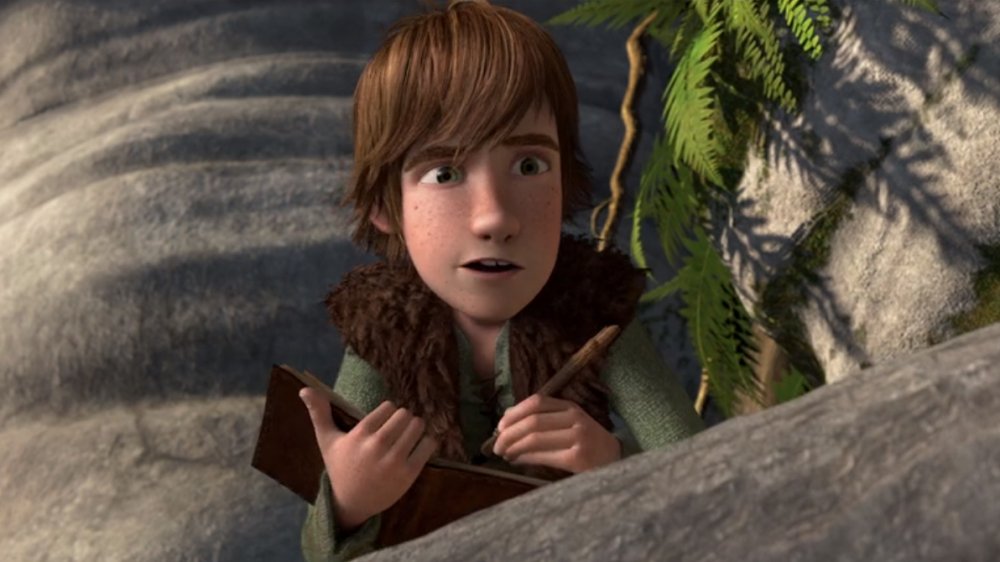Things Only Adults Notice In How To Train Your Dragon
The How to Train Your Dragon franchise is a treat for all ages. Based on the book series by Cressida Cowell, the tone and setting drastically changed when director Dean DeBlois and Chris Sanders (both of whom worked on Lilo & Stitch) were brought on board. And the film is all the better for the overhaul. After all, many of these changes helped expand the story to cater to an older demographic.
As such, there's a lot happening in these films that's going to silently fly over the heads of children, like a Night Fury on a moonless night. So after watching these movies through adult eyes — thoughtfully stroking our grown-up Viking beards as we did so — we put together an exhaustive list of the film's many strange anachronisms, hidden themes, and plot developments that younger audiences wouldn't notice. From impressive inventions to major retcons, here are the things only adults notice in the How to Train Your Dragon series.
Dragons are ridiculously easy to train
Given that the title of this series is How to Train Your Dragon, you'd imagine that a person attempting to train a dragon and having difficulty doing so would happen at least once in one of these movies. It's so obvious that it feels silly to even say it.
That's why it's so strange that a big revelation of the first film is that dragons are secretly the most easily domesticable species in existence. It takes Hiccup a while to realize that Toothless has a soft side, but as soon as he does, Toothless instantly becomes a giant, adorable lizard puppy, and he and Hiccup become best friends for life. Later, when Hiccup introduces his peers to the other dragons that Berk has in captivity, as soon as they let their respective guards down, these other dragons also immediately transform into perfectly compliant mounts.
Turns out the way to "train your dragon" is actually just "don't kill them with a sword." But to be fair, we can understand why they named the series what they did. It's a cool name, and in the original books, dragons are difficult to train. And also, it might've been a bit too wordy to name the film How to Convince Your Dad That Dragons Are Actually Pretty Chill.
These are some pretty tame Vikings
The people of Berk are consistently referred to as "Vikings," which is derived from an Old English word meaning "pirate." As you might imagine, actual historical Vikings were seafaring raiders. Due to a combination of having scarce resources at home and poorly defended neighbors all around, Vikings were known for attacking foreign ships, raiding foreign towns, and killing those who stood in their way. That's why it's more than a little odd (although understandable since this is a kids' movie, after all) that across three films, the Vikings of Berk never even discuss the possibility of raiding or killing anyone.
To be fair, actual Vikings weren't only pirates. They also did some farming in the off-season, and we do see that the people of Berk raise sheep. However, most adult Berkians certainly look a lot more like warriors than they do like farmers, so if they aren't gaining resources from burning and pillaging nearby villages, then it's not clear exactly how their massive standing army of muscley, bearded men is supporting itself.
When all your heroes are all ostensibly Vikings, and yet no form raiding or pillaging is addressed across three movies, even in passing, it becomes somewhat of an elephant in the room. Are we to take it that Hiccup and Astrid are bashing in the heads of their unsuspecting neighbors in between films, or are these so-called "Vikings," in fact, completely toothless?
The setting of How to Train Your Dragon is basically a video game
How to Train Your Dragon takes place in a fantasy version of the Middle Ages, so you'd think that it might have parallels to the myths of that time period. But after a closer analysis, you'll see that the underlying logic of the world reflects a much more modern sensibility.
In actual ancient myths, the world was a scary place, and the monsters were typically presented as inhuman horrors that couldn't be understood, let alone "trained." Mythological dragons like Fafnir were also typically conceived of as individual legendary beings, rather than a species or collection of related species.
On the other hand, How to Train Your Dragon feels much more like a video game than any sort of ancient myth. The world is a system of rules that can be learned and mastered. Dragons come in one of a few recurring subtypes, and each type has specific powers and weaknesses. Each dragon species has its own predictable limit of how many "shots" it can spit before its fire breath runs out, like ammunition or MP. They even have trading cards that list their statistics.
Toothless himself also "levels up" a few times throughout the series, such as when he gains his back spines that improve his maneuverability, or when he masters his "alpha" form which allows to command other dragons. You can practically hear Fishlegs telling Hiccup, "The pros all agree that the alpha form is OP, clearly the optimal build for a Night Fury. Don't even bother with the rest of the skill tree."
Most of the cast is superfluous
The first How to Train Your Dragon film has an enormous supporting cast. Beyond just Hiccup and Toothless, there's also Hiccup's father, Stoick, and the blacksmith, Gobber. Then there's Hiccup's fellow dragon hunters-in-training: the hyper-competent Astrid, the brash Snotlout, the nerdy Fishlegs, and the hard-headed twins, Ruffnut and Tuffnut. Although it's a little crowded, the film manages to give each character just enough of a plotline to justify their presence.
But this series is, at its heart, not an ensemble story. It wants to be primarily about the friendship between Hiccup and Toothless. Because of this, the writers just don't seem to know what to do with the profusion of supporting characters in the later films. Most rarely have anything to do, with the possible exception of Astrid, but she only exists as Hiccup's love interest. The rest sometimes get the occasional middling joke or forgettable subplot, but that's about it. And if it wasn't crowded enough, the second movie also adds Hiccup's mother, Valka, and Eret the dragon trapper.
Perhaps this is why some other ongoing animated franchises have left out major characters in later installments when they're no longer relevant, such as the almost complete removal of Fix-It Felix and Sergeant Calhoun from Ralph Breaks the Internet and the dramatic reduction of the cast from Toy Story 2 to Toy Story 3. We're real sad that Stoick died in How to Train Your Dragon 2, but honestly, that movie didn't have room for any more subplots.
Only the adults have Scottish accents
You might not notice it the first time you watch the film, but once you hear it, you can't un-hear it. Despite taking place in the nebulous past, somewhere very Europe-y, the children of Berk all speak with American accents, and they're largely played by US-born actors like America Ferrera, Jonah Hill, and the close enough Canadian Jay Baruchel.
This is all well and good, as it takes place in a fantasy foreign land, and these characters probably wouldn't even be speaking English anyway. As long as it's consistent, who cares what kind of accent they have, right? Except that it isn't consistent. For some reason, all the adults of Berk are played by Scottish actors like Gerard Butler and Craig Ferguson, and their characters speak with Scottish accents. Note that when Hiccup does an impression of his father, he affects a Scottish accent.
Writer/director Dean DeBlois revealed in an interview that the Scottish accents came about accidentally because of Gerard Butler's casting, and then the filmmakers just decided to go with it when they realized that it could have a deeper symbolic meaning. Given that the first film is largely about a generational divide, these two different accents act as an outward manifestation of just how different the children of Berk are from their parents. DeBlois figured that the "Scottish accent is a remnant of wherever they came from," but the new generation speaks in the "Berk accent, which just happens to sound like the American one."
The real dragon is toxic masculinity
When you watch these films with adult eyes, you realize that they aren't about training dragons at all. They're really about training people to cure themselves of toxic masculinity. A recurring theme throughout the How to Train Your Dragon movies is that machismo is the source of most problems in the world, and the solution to these problems is empathy.
In the first film, the humans have reached a sort of terrible equilibrium in their endless war against the dragons. The bloodshed has gone from being something regrettable that the Vikings need to do in order to survive to being a way of life that they take pride in. Hiccup's father wants him to be a dragon slayer simply because that's what men do, even though it's clearly making Hiccup miserable. Cultural inertia has been perpetuating this system for so long that its become invisible, but it's slowly killing everyone trapped within it. What makes Hiccup a hero is that he's able to put an end to the conflict with the dragons, and he does it not by killing them, but by befriending them.
Later films continue this trend. Drago Bludvist's evil stems from his constant need to prove his prowess through killing or dominating others, and Grimmel the Grisly is fairly explicitly presented as what a person like Hiccup would've become if he'd ignored his empathy and killed the first Night Fury he captured as a teen.
Gobber is gay
There are many memorable denizens of Berk, but without a doubt, the most adorable viking of the bunch is Gobber, the village blacksmith. He's played to perfection by Craig Ferguson, and beyond his numerous hilarious and heartwarming moments, there's also a brief moment in How to Train Your Dragon 2 that hints an additional layer to his character.
When Hiccup's father, Stoick, is reunited with his missing wife, Valka, their interactions start off sweet for a moment, but then they start feuding pretty much immediately. This interaction leads to Gobber commenting, "This is why I never married. This and one other reason." At this point, Gobber gets cut off, and the issue is never brought up again, so we never learn why Gobber never married. There are a few different ways to read this unfinished statement, but perhaps the most interesting way to do so is that Gobber was about to admit to being gay.
This interpretation was confirmed by screenwriter Dean DeBlois. Apparently, the line was ad-libbed by Ferguson in the booth, and DeBelois, himself a gay man, decided to keep it in, since it was an opportunity for a bit of queer representation in a mainstream film. Perhaps this is why Gobber is able to relate to Hiccup more than any of the other Vikings in town. He also grew up feeling like an outsider. While Stoick keeps trying to change his son, Gobber keeps telling him "stop trying so hard to be something you're not."
The later How to Train Your Dragon movies are full of retcons
The first Dragon film tells a relatively self-contained story. Because of this, later installments expand the setting somewhat, and although they usually do a good job of convincing us these new twists were planned all along, sometimes veteran moviegoers will be able to spot the seams.
In the first movie, Hiccup's mother, Valka, is absent and strongly implied to be dead. In the sequel, we learn that she actually fled Berk because she believed that dragons were peaceful creatures, and she wanted to live among them. The weird thing is that apparently Stoick knew this about her? You think it would've come up back when his son started doing the exact same thing.
There's a similar bit of retroactive worldbuilding in The Hidden World, namely the titular Hidden World itself. In an early flashback, we see Stoick telling an ancient story to a young Hiccup about this fabled mythological land. It should be painfully clear to any seasoned filmgoing audience that this ancient legend is, in fact, brand new to this film.
Worldbuilding as you go isn't uncommon in ongoing cinematic franchises. Marvel does it constantly. The existence of Killian in Iron Man 3 and Hela in Thor: Ragnarok aren't foreshadowed in the earlier films, and yet both characters are introduced as if they've always been here. They were just "forgotten by history." But after you've heard that phrase a couple times, you'll eventually learn it's code for "we didn't plan this when we wrote the first one."
Hiccup's inventions are absurdly advanced
We know from the first film that Hiccup is an anachronistic super-inventor, à la Leonardo da Vinci. Early on in that movie, Hiccup presents a new invention to his father: a giant-sized bola launcher made for taking down dragons in flight. Later, after he becomes friends with Toothless, he creates a custom saddle for his new companion and a prosthetic fin to replace the one that Toothless lost. This is all a bit advanced for the Dark Ages, but none if it is totally unbelievable.
When the sequels hit, all pretense of historical accuracy has been hurled into the ocean. Hiccup has a wingsuit that lets him glide, grenades made from zippleback breath, and a retractable flaming sword that's basically a lightsaber. Additionally, the city of Berk has somehow also been outfitted with elevators. Hiccup has blown way past Leonardo da Vinci and is rapidly approaching Batman.
But definitely Hiccup's most "don't think about it too hard" inventions are the fireproof suits he makes for himself and his fellow dragon riders, which he states in the third film are made from dragon scales. Is Hiccup hunting dragons for their skins? Were these skins are ethically harvested from dragons that died from natural causes? Or do dragons perhaps shed their skins periodically like real-life snakes? Hopefully that last option is the truth, because Hiccup's suit seems to be made from a Night Fury.
There are endless recurring lines in the How to Train Your Dragon series
Much of what we're doing here is nitpicking, pointing out problems that younger kids might not notice, but it's also worth highlighting the good stuff in these films that might fly over the heads of the younger members of the audience, such as interesting recurring lines of dialogue that appear throughout the series.
The most obvious recurring bit is Hiccup's "This is Berk" speech, which he delivers once at the beginning and once at the end of each film, but there are also more subtle recurring lines. Phrases like "we're vikings," "I did this," and "probably something stupid" appear and reappear all throughout Hiccup's story, and they take on a different meaning each time they're spoken.
But perhaps the best recurring line first happens when Hiccup offers Astrid a ride on Toothless. He extends his hand towards her and says, "Let me show you." You might not have noticed it the first time you saw How to Train Your Dragon 2, but when Hiccup first meets Drago Bludvist, this line pops up again. As the two characters have a debate about whether or not dragons are capable of kindness, in order to prove his point to Drago, Hiccup offers him a hand in the same way he did to Astrid and says in the exact same way, "Let me show you." Alas, as much as we would've loved to see those two have a romantic dragon ride through the clouds, it wasn't meant to be. Toxic masculinity strikes again.
Hiccup is left-handed
Hiccup is left-handed. It's true in the books, and it's true in the movies, and if you analyze the way How to Train Your Dragon presents handedness, it's surprisingly revealing of the film's deeper themes.
When Hiccup starts his combat training, Stoick gives Hiccup their family's ax and tells his son, "When you carry this ax, you carry all of us with you." This connects the ax, symbolically, with Berk's dragon-killing legacy. But when Hiccup uses the ax in training, he holds it in his right hand. This reflects how, in many pre-modern cultures, left-handed people were forced to do things right-handedly, because left-handedness was viewed as an abomination. People in Berk who are born different are forced to act like everyone else.
As you might imagine, Hiccup is very bad at using an ax with his off-hand, and in his second training session, the ax is completely destroyed. Clearly, Hiccup isn't meant to continue his family's legacy of killing. However, Hiccup holds his shield in his left hand, his dominant hand, and thus manages to use his shield more skillfully. This reflects the idea that, unlike the other Vikings, who are meant for killing, Hiccup is meant for protecting.
Additionally, when Hiccup draws Toothless, he does so with his left hand. When he is with his dragon, outside the confines of Viking society, he is no longer forced to invert his natural instincts. He is finally allowed to be himself.
